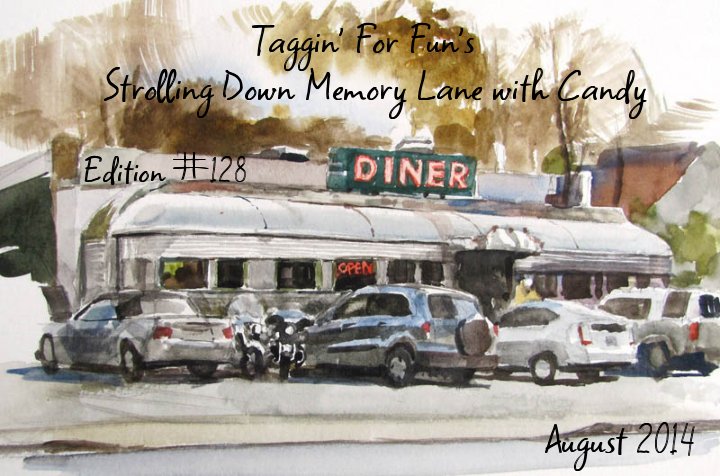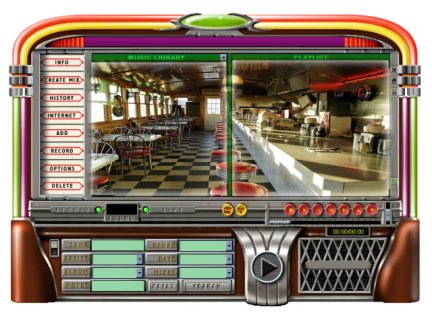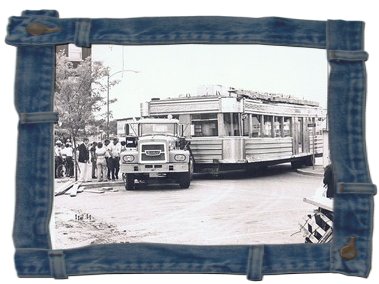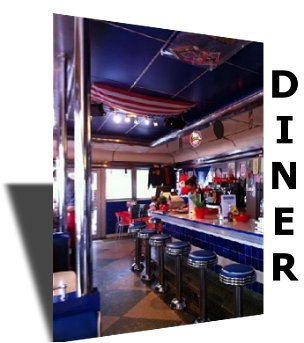
Let's stroll on over for some burgers and fries or maybe some sunny side up eggs. Today we visit...
THE AMERICAN DINER

We had a few of these diners in Tampa when I was growing up and it was the place to go after a night out before heading home..and a few years ago while visiting Lancaster Pennsylvania I was thrilled to find a real diner! Truck drivers, juke box on the table and a gum smacking waitress! I was in heaven!
With its chrome counter and cherry pie, the diner is an icon of American culture.
Stacked pancakes, with sausage. Eggs over-easy with home fries and toast. Cheeseburger deluxe. Turkey club. Meatloaf dinner. "It's comfort food, made from recipes like Mom used to make," says diner owner Otto Meyer.
This is a quintessential American experience.
Add a booth, a Formica counter and a cup of joe - as diner patrons call their coffee.
The first such establishment opened in 1872 in Providence, Rhode Island - a "night lunch wagon" to serve those who worked and played long after other restaurants had closed for the night.
Its mix of open-all-hours eating and cheap, homemade food proved a hit, and the formula has been repeated ever since.
Today the diner occupies a place in the American heartland. No US election campaign is complete without a stop at a diner to emphasise the candidate's everyman or everywoman credentials.

You're in Pennsylvania at a diner and in the middle of two guys. One is the chief of police and the other is just some character. The policeman looks over and says, 'Didn't I arrest you last year?' and the guy says, 'Yes you did - pass the ketchup.'"
Its graceful lines had been cribbed from the railroad dining car. In fact, the all-American origins of the diner go back even further than that, to the chuck wagon which fed cowboys on the range. From films such as Pulp Fiction and When Harry Met Sally, to books by John Updike, Jack Kerouac and Vladimir Nabokov, and the paintings of Norman Rockwell and Edward Hopper, the diner plays an important part.

Walter Scott was the 17 year old young entrepreneur from Providence, Rhode Island who is credited with the idea of what we now call the great American “diner.” In 1858, this young man had an idea to supplement his income by selling sandwiches and coffee from a basket to night workers and late night members of men’s clubs. Business boomed.
The successes of these wagons prompted the formation of companies to manufacture lunch wagons for sale.
During this same time period, horse-drawn streetcars were being replaced by electric cars.Many of the old cars were purchased and converted into eateries. Owners more concerned with making a living than with maintaining their surroundings began to earn the reputations of “greasy spoon” and became gathering places for objectionable patrons.
In 1920 when women received the vote, diner owners began to try and spruce up their image to try and attract women clientele. Flowers were added, cars were painted, restrooms were added as well as tables and longer length counters. Many different manufacturers had sprung up. Styling was borrowed from the railroad’s Pullman dining cars, creating the term “diner.” Manufacturers began to change the image of the dining cars and night lunches. Many dining cars added the prefix “Miss” to their names to try and soften their images.

In the 1940s and 1950s, stainless steel and large windows were incorporated into the design of diners to attract the attention of passers-by. Important new developments had come along – air-conditioning, ventilation and lighting. Space was the new frontier and it was reflected in the design of diners in the mid to late 1950s. Nearly 5,000 diners were operating in the United States during this time.
It was during the 1960s, with the introduction of fast food, that the formula for success of the American diner took such a hit. It seemed that commuters and urban dwellers preferred prompt, clean, predictable menus geared to a population in a hurry and on the move. Diners suddenly became “obsolete relics” to many, resulting in a change of the diner look to brick arches, flagstone, and dark-stained wood and mansard roofs. They are known as colonial catastrophes and Mediterranean monstrosities. This new wave of diners abandoned the familiar imagery of their past as they attempted to look like family restaurants.
In the late 1970s, a revival began with a new interest in diners. Three of the old remaining builders began to manufacture new diners in the old styles. New companies joined this growing market to build retro looking diners. These diners provoke an image of a kinder, gentler America and a renewed interest in our values of yesteryear in a time of such uncertainty as well as homemade quality food. Today, Webster’s defines diners as “a restaurant usually resembling a dining car in shape.”
Today when we are asked to support small businesses maybe you can stop into one of the diners if you're lucky enough to still have one in your area....
Don't forget to try the cherry pie!




